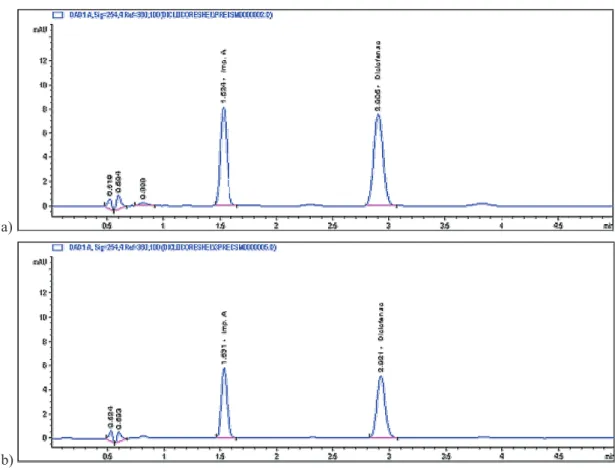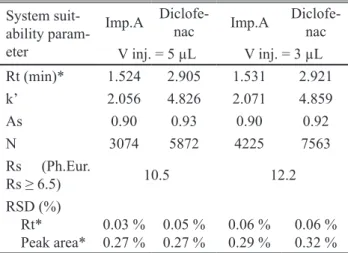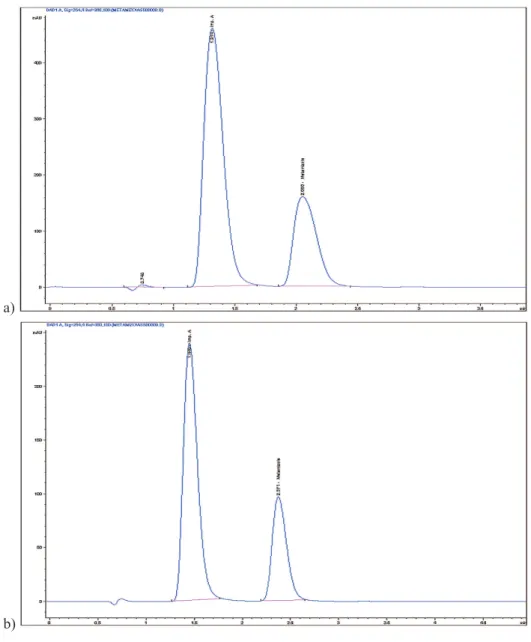ISSN 1409 - 8695 UDC: 543.544.5.068.7 Original scientiic paper
Transfer of pharmacopoeial liquid chromatography
reversed-phase methods for determination of related compounds in
diclofenac sodium and metamizole sodium from conventional
to core-shell column
*
Katerina Brezovska
1, Gabriela Petrovska
1, Jelena Acevska
1, Natalija Nakov
1,
Ana Poceva-Panovska
1, Jasmina Tonic-Ribarska
1, Maja Hadzieva
2, Aneta Dimitrovska
11Faculty of Pharmacy, University Ss. Cyril and Methodius, Skopje, Macedonia 2Alkaloid AD, Skopje, 1000 Skopje, Republic of Macedonia
Received: January 2015; Accepted: April 2015
Abstract
Core-shell silica particles were developed as a new material for chromatographic stationary phases in order to provide fast and high efi-ciency separations of small and large molecules and complex samples, at pressures compatible with conventional HPLC equipment. The aim of our work was to show the applicability of the HPLC columns based on a core-shell technology for determination of related substan-ces in diclofenac sodium and in metamizole sodium using the methods described in the corresponding monographs of the European phar-macopoeia. The obtained results have shown that the proposed methods can be successfully transferred on core shell column, with suitable adjustment of injection volume and low rate. The advantage of using core-shell column is fast and highly eficient separation on conven -tional HPLC equipment with increased sensitivity of the method and high throughput of the analysis, providing enhanced lab productivi-ty and reduced costs.
Key words: core-shell column, HPLC, diclofenac sodium, metamizole sodium
* kami@ff.ukim.edu.mk Introduction
Recent developments in liquid chromatography (LC) are focused in obtaining HPLC columns with higher efi -ciency and increased resolution in less analysis time. For that purpose, shorter columns packed with smaller parti-cle size (3 μm and sub-2 μm) have been introduced in LC. The small particle diameter improves the separation kine- tics and therefore eficiency, but at the expense of increased operating backpressure, requiring specially designed ul-tra high performance pumping and low system (Brice et al., 2009; Naijun, Andrew, 2007). Core-shell silica parti-cles were developed as a new material for chromatograph-ic stationary phases in order to provide fast and high efi
con-columns have been mostly used for reversed-phase HPLC, but core-shell particles have been also employed in hy-drophilic interaction liquid chromatography (HILIC) and chiral separation (Destefano et al., 2008; Berger 2011; Wu, et al., 2013). These materials have shown superior per-formance for separating both small molecules (Song et al., 2009; Yang et al., 2011) and larger compounds such as peptides (Schuster et al., 2012) and proteins (Fekete et al., 2012). The beneits of transferring the HPLC methods from columns packed with fully porous silica particles to core-shell columns are in maintaining column performance and minimizing operating dificulties, providing signii -cant time and cost savings (Hayes et al., 2014).
The aim of our work was to show the applicability of the HPLC columns based on a core-shell technology for determination of related substances in diclofenac sodium and in metamizole sodium using the methods described in European pharmacopoeia (Ph.Eur.). The Ph.Eur. mono-graph for Diclofenac Sodium 01/2008:1002 requires use of conventional end-capped octylsylil silica gel for chro-matography R (5 μm) with isocratic elution for determi -nation of related substances. This monograph has been re-cently updated to version 07/2014:1002, where the method requires use of conventional end-capped octadecylsilyl si- lica gel for chromatography R (5 µm). In the monograph for Metamizole sodium (01/2008:1346, Ph. Eur.), for deter-mination of related substances, base deactivated octadecyl-silyl silica gel for chromatography R (5 μm) is proposed as a stationary phase, while in recently updated monograph version 04/2014:1346 (Metamizole sodium monohydrate) the method has been changed to ultra high performance liquid chromatography, requiring the use of column packed with end-capped octadecylsilyl silica gel for chromatogra-phy R (1.8 µm).
In our study we have applied the columns based on core-shell technology for determination of related sub-stances of diclofenac sodium and metamizole sodium us-ing the methods described in the Ph.Eur. monographs 01/2008:1002 and 01/2008:1346 respectively.
Experimental
Chemicals and standards
Diclofenac sodium, diclofenac impurity A, meta-mizole sodium and metameta-mizole impurity A certiied refe-rence standards, were purchased from EDQM (Strasbourg, France). Phosphoric acid (85 %), sodium dihydrogen phos-phate, (Ph.Eur., grade for analysis), potassium hydrogen phosphate dibasic (analytical grade) and triethylamine were purchased from Merck, Germany. Methanol (HPLC grade) and acetonitrile (HPLC grade) were purchased from Carlo Erba Reagents, France. Water R, was obtained with a TKA-LAB Reinstwasser system (Niederelbert, Germany).
Chromatographic Conditions
HPLC separation was performed on Agilent 1100 and Agilent 1200 LC Systems (used as a conventional HPLC with pressures up to 400 bar). ChemStation software, Ver-sion A.10.02 (for experiments conducted on Agilent 1100) and Version B.04.03 (for experiments conducted on Agi-lent 1200) was used for data acquisition and instrument control.
Method for related substances in diclofenac sodium
The separation was performed on Poroshell 120 EC C8 50 x 4.6 mm, 2.7 μm (Agilent) using a mixture of 34 volumes of a solution containing 0.5 g/L phosphoric acid and 0.8 g/L sodium dihydrogen phosphate R, adjusted to pH 2.5 with phosphoric acid R and 66 volumes of meth-anol R as a mobile phase. The column temperature was 25oC. Flow rate was 1 mL/min. Injection volume was 3 μL.
UV detection was performed at 254 nm.
System suitability solution for diclofenac sodium
Reference solution b, containing diclofenac sodium (5 μg/mL) and diclofenac impurity A (5 μg/mL), prepared as described in Ph.Eur. monograph for Diclofenac Sodi-um 01/2008:1002 was used as system suitability solution.
Method for related substances in metamizole sodium
The separation was performed on Kinetex XB-C18, 50 mm x 2.1 mm, 5 μm (Phenomenex, Inc), using a mixture of 28 volumes of methanol R and 72 volumes of a buffer solu-tion containing 1000 volumes of a 6.0 g/L solusolu-tion of sodi-um dyhidrogen phosphate R and 1 volsodi-ume of triethylamine R, pH 7.0 (adjusted with strong sodium hydroxide solution R) as a mobile phase. The column temperature was 25oC. Flow rate was 0.2 mL/min. Injection volume was 0.5 μL. UV detection was performed at 254 nm.
System suitability solution for metamizole sodium Reference solution e, containing metamizole sodium (0.3 mg/mL) and metamizole impurity A (0.4 mg/mL) pre-pared as described in Ph.Eur. monograph for Metamizole sodium 01/2008:1346 was used as system suitability so-lution.
Results and Discussion
phic system requirements according to Ph.Eur. (2.2.46 Chromatographic separation techniques). This chapter also limits the extent to which the various parameters of a chro-matographic test may be adjusted to satisfy the system suita- bility criteria without fundamentally modifying the me-thods. According to these requirements the injection vo-lume may be decreased, provided detection and repeatabi-lity of the peak(s) to be determined are satisfactory and no increase is permitted, and the low rate may be adjusted (± 50 per cent). Regarding the column parameters there is no change of the identity of the substituent of the stationary phase permitted (e.g. no replacement of C18 by C8) and the particle size may be reduced maximum 50 per cent, but it cannot be increased. The length of the column and the in-ternal diameter may be adjusted ± 70 per cent and ± 25 per cent respectively.
Method for related substances in diclofenac sodium
The method for determination of related substan- ces in diclofenac sodium described in the Ph. Eur. mono-graph 01/2008:1002, was transferred from conventio- nal end-capped octylsylil silica gel for chromatography R (0.25 m x 4.6 mm; 5 μm) on core-shell column (C8, 50 mm
x 4.6 mm; 2.7 μm). All method modiications, except the column length, were within the limits of Ph.Eur. (2.2.46). Reducing the column internal diameter facilitates sensitivi-ty improvements and shorter columns can often deliver the required resolution (Pereira, 2012). The reduction of col-umn size results in reduction of colcol-umn volume, which re-quired scaling down the injection volume from 20 μL to 5 μL and 3 μL (Figure 1).
Satisfactory system suitability requirements of the transferred method were obtained with the injection volu-me of the sample of 5 μL and 3 μL in total analysis tivolu-me of 5 minutes (1.6 times of the retention time of diclofenac, Rt = 2.9 min). The requirement in Ph.Eur monograph for Diclofenac sodium (01/2008:1002) for the resolution (Rs) between the peaks from diclofenac sodium and impurity A (at least 6.5) was fulilled (Rs = 10.6 for volume of injec -tion 5 µL and Rs =12.2 for volume of injec-tion 3 µL). The obtained values from system suitability tests (Table 1) for number of theoretical plates (N), retention factor (k’), reso- lution (Rs), symmetry factor (As) and relative standard de-viation (RSD %), indicate on a satisfactory column efi -ciency and adequate performance of the chromatogra- phic system.
a)
b)
The limit of detection (DL) and limit of quantiication (QL) were determined on the basis of standard deviation (SD) of the response and the slope, obtained from regre-ssion analysis of relationship between the response (peak area) and the concentration of diclofenac sodium in con-centration range from 0.2 µg/mL to 5 µg/mL (0.2, 0.5, 1, 2, 3, and 5 µg/mL). The obtained values for limit of detec-tion, DL = 0.05 µg/mL (volume of injection 5 µL) and DL = 0.03 µg/mL (volume of injection 3 µL) and for the limit of quantiication, QL = 0.17 µg/mL (volume of injection 5 µL) and QL = 0.08 µg/mL (volume of injection 3 µL) are below the disregard limit (0.5 µg/mL) given in the Ph.Eur. mono-graph, indicating on satisfactory sensitivity of the method.
The obtained results have shown that using the core-shell column for determination of related substances in di-clofenac sodium, satisfactory method performance are ob-tained in total analysis time from 5 to 7 minutes. The up-dated method for determination of related substances in diclofenac sodium in Ph. Eur. monograph 07/2014:1002, could be also transferred from conventional end-capped octadecylsilyl silica gel for chromatography R (0.25 m x 4,6 mm; 5 μm) on a suitable core-shell column (C18), in order to shorten the analysis time (25 min according to monograph 07/2014:1002, Ph.Eur.).
Method for related substances in metamizole sodium
The method for determination of related substances in metamizole sodium described in the Ph. Eur. monograph 01/2008:1002, was transferred from conventional base de-activated octadecylsilyl silica gel for chromatography R (0.25 m x 4.6 mm; 5 μm) on core-shell column (XB-C18, 50 mm x 2.1 mm, 5 μm). The modiication of the meth -od parameters regarding the column dimensions were out-side of the limits of Ph.Eur. (2.2.46). Reduction of the
col-umn dimensions has the direct beneit on sensitivity and re -duces the analysis time (Pereira, 2012). Due to the reduction of column size the injection volume was decreased from 10 μL to 0.5 μL (Figure 2). The adjustment of the method inclu-ded also reduction of the low rate from 1 mL/min to 0.2 mL/min, which is within the limits of Ph.Eur. (2.2.46), of nece-ssary adjustment of the low rate, when column di -mensions are changed (minimum low rate is 0.1 mL/min). Reduction of the injection volume to 1 μL did not gave satisfactory separation (Rs = 2.29) of metamizole from im-purity A (Ph.Eur., monograph limit is Rs ≥ 2.5). Satisfacto -ry system suitability requirements were obtained with the injection volume of 0.5 μL in total analysis time of 9 min -utes (4.5 times of the retention time of metamizole, Rt = 2.15) and the value for resolution (Rs) between metamizole and impurity A (Rs = 3.11) fulills the requirement of the Ph.Eur monograph (Rs ≥ 2.5). The obtained values from system suitability tests (Table 2) for number of theoretical plates (N), retention factor (k’), resolution (Rs), symmetry factor (As) and relative standard deviation (RSD %), indi-cate on a satisfactory column eficiency and adequate per -formance of the chromatographic system.
Table 2. System suitability values for the method for rela- ted substances of metamizole sodium obtained using core-shell column (C18)
System suitability
parameter Imp.A Metamizole
Rt* 1.401 2.148
k’ 1698 3.135
N 531 1315
Rs (Ph.Eur. Rs ≥ 2.5) 3.11 RSD Rt* Peak area* 0.16 % 0.53 % 0.26 % 0.55 %
*n = 6.
The limit of detection (DL) and limit of quantiica -tion (QL) were determined on the basis of standard devia-tion (SD) of the response and the slope, obtained from the regression analysis of relationship between the response (peak area) and the concentration of metamizole sodium in concentration range from 5 µg/mL to 50 µg/mL (5, 10, 20, 25, 30, and 50 µg/mL). The obtained values for limit of de-tection, DL = 0.33 µg/mL and for the limit of quantiica -tion, QL = 0.99 µg/mL are below the disregard limit (1.25 µg/mL) given in the Ph.Eur. monograph, indicating on sa-tisfactory sensitivity of the method.
The updated monograph 04/2014:1346 of Metamizole sodium monohydrate, for the method for determination of related substances requires an end-capped octadecylsilyl silica gel for chromatography R (50 mm x 4.6 mm; 1.8 µm). For this type of column, the use of ultra high per-formance liquid chromatography system is necessary. Ac-Table 1. System suitability values for the method for rela-
ted substances of diclofenac sodium obtained using core-shell column (C8)
System suit-ability param-eter Imp.A Diclofe-nac Imp.A Diclofe-nac V inj. = 5 µL V inj. = 3 µL Rt (min)* 1.524 2.905 1.531 2.921
k’ 2.056 4.826 2.071 4.859
As 0.90 0.93 0.90 0.92
N 3074 5872 4225 7563
Rs (Ph.Eur.
Rs ≥ 6.5) 10.5 12.2
RSD (%) Rt* Peak area* 0.03 % 0.27 % 0.05 % 0.27 % 0.06 % 0.29 % 0.06 % 0.32 %
cording to the monograph, the analysis times of the method should be around 9 minutes (4.5 times of the retention time of metamizole with Rt around 2 min), which is the same as the analysis time obtained using core-shell column. The advantage of using the column based on core-shell tech-nology is in obtaining comparable and satisfactory column performance on conventional HPLC equipment, available in almost any laboratory.
Conclusion
The results have shown that the pharmacopoeial me-thods for determination of related substances in diclofenac sodium and in metamizole sodium are successfully trans-ferred on core-shell column, with suitable adjustment of
injection volume and low rate. The adjusted methods us -ing core-shell columns fulill the Ph. Eur. requirements for system suitability and achieved signiicant improvements in eficiency performance, resolution and sensitivity.
The advantage of using core-shell column is fast and highly eficient separation on conventional HPLC system with increased sensitivity and throughput of the method, providing enhanced lab productivity and reduced costs.
References
Berger, T.A., 2011. Characterization of a 2.6 μm Kinetex porous shell hydrophilic interaction liquid chromatography column in supercritical luid chromatography with a comparison to 3 μm totally porous silica. J Chromatogr A. 1218(28):4559-4568.
a)
b)
Brice, R.W., Zhang, X., Colón, L.A. 2009. Fused-core, sub-2 microm packings, and monolithic HPLC columns: a comparative evaluation. J Sep Sci. 32(15-16):2723-2731. Destefano, J.J., Langlois, T.J., Kirkland, J.J. 2008. Characteristics
of supericially-porous silica particles for fast HPLC: some performance comparisons with sub-2-microm particles. J Chromatogr Sci. 46(3):254-260.
Destefano, J.J., Schuster, S.A., Lawhorn, J.M., Kirkland, J.J. 2012. Performance characteristics of new supericially porous particles. J Chromatogr A. Oct 5;1258:76-83. Guiochon, G., Gritti, F., 2011. Shell particles, trials, tribulations
and triumphs. J Chromatogr A. 1218(15):1915-1938. European pharmacopoeia, 8th edition, 2013.
Fekete, S., Berky, R., Fekete, J., Veuthey, J.L., Guillarme, D. 2012. Evaluation of a new wide pore core-shell material (Aeris WIDEPORE) and comparison with other existing stationary phases for the analysis of intact proteins. J Chromatogr A. 1236:177-188.
Hayes, R., Ahmed, A., Edge, T., Zhang, H. 2014. Core-shell particles: preparation, fundamentals and applications in high performance liquid chromatography J Chromatogr A. 1357, 36-52.
Kirkland, J. J., Schuster, S.A., Johnson, W.L., Boyes, Barry. E. 2013. Fused -core particle technology in high-performance liquid chromatography: An overview. J. Pharm. Anal. 3 (5) 303 - 312.
Naijun, Wu., Andrew, M. 2007. Clausen Fundamental and practical aspects of ultrahigh pressure liquid chromatography
for fast separations. J. Sep. Sci. 30 (8) 1167-1182.
Pereira, L., 2012. An Overview of Core Enhanced Technology for Fast, High Eficiency HPLC, Chromatography today, May, 14-22.
Ruta, J., Zurlino, D., Grivel, C., Heinisch, S., Veuthey, J.L., Guillarme, D. 2012. Evaluation of columns packed with shell particles with compounds of pharmaceutical interest. J Chromatogr A. Mar 9; 1228:221-231.
Song, W., Pabbisetty, D., Groeber, E.A., Steenwyk, R.C., Fast, D.M. 2009. Comparison of fused-core and conventional particle size columns by LC-MS/MS and UV: application to pharmacokinetic study. J Pharm Biomed Anal. 15;50(3):491-500.
Schuster, S.A., Boyes, B.E., Wagner, B.M., Kirkland, J.J., 2012. Fast high performance liquid chromatography separations for proteomic applications using Fused-Core® silica particles. J Chromatogr A. 1228:232-241.
Wu, X., You, L., Di, B., Hao, W., Su, M., Gu, Y., Shen, L. 2013. Novel chiral core-shell silica microspheres with trans-(1R,2R)-diaminocyclohexane bridged in the mesoporous shell: synthesis, characterization and application in high performance liquid chromatography. J Chromatogr A. 1299:78-84.
Yang, P., McCabe, T., Pursch, M. 2011. Practical comparison of LC columns packed with different supericially porous particles for the separation of small molecules and medium size natural products. J Sep Sci. 34(21):2975-2982.
Резиме
Трансфер на фармакопејски
методи за определување
на онечистувања базирани на реверзно-фазна течна
хроматографија од конвенционална на
core-shell
колона
Катерина Брезовска
*
1, Габриела Петровска
1, Јелена Ацевска
1, Наталија Наков
1,
Ана Поцева-Пановска
1, ЈасминаТониќ-Рибарска
1, Маја Хаџиева
2, Анета
Димитровска
11Фармацевтски факултет, Универзитет „Св. Кирил и Методиј”, Скопје, Република Македонија 2 Алкалоид АД Скопје, 1000 Скопје, Република Македонија
Клучни зборови: core-shell колона, HPLC, диклофенак натриум, метамизол натриум
Core-shell силика честичките, се развиени како нов материјал за хроматографски стационарни фази, со цел обезбедување на високо ефективно разделување на мали и големи молекули, како и на комплексни смеси со притисоци компатибилни со конвенционална HPLC опрема.Целта на овој труд беше да се покаже применливоста на HPLC колоните базирани на core-shell технологија за определување на сродни супстанции на диклофенак натриум и на метамизол натриум со примена на методите опишани во соодветните монографии во Европската фармакопеја. Резултатите покажаа дека предложените методи може успешно да се трансферираат на core-shellколона со соодветно


